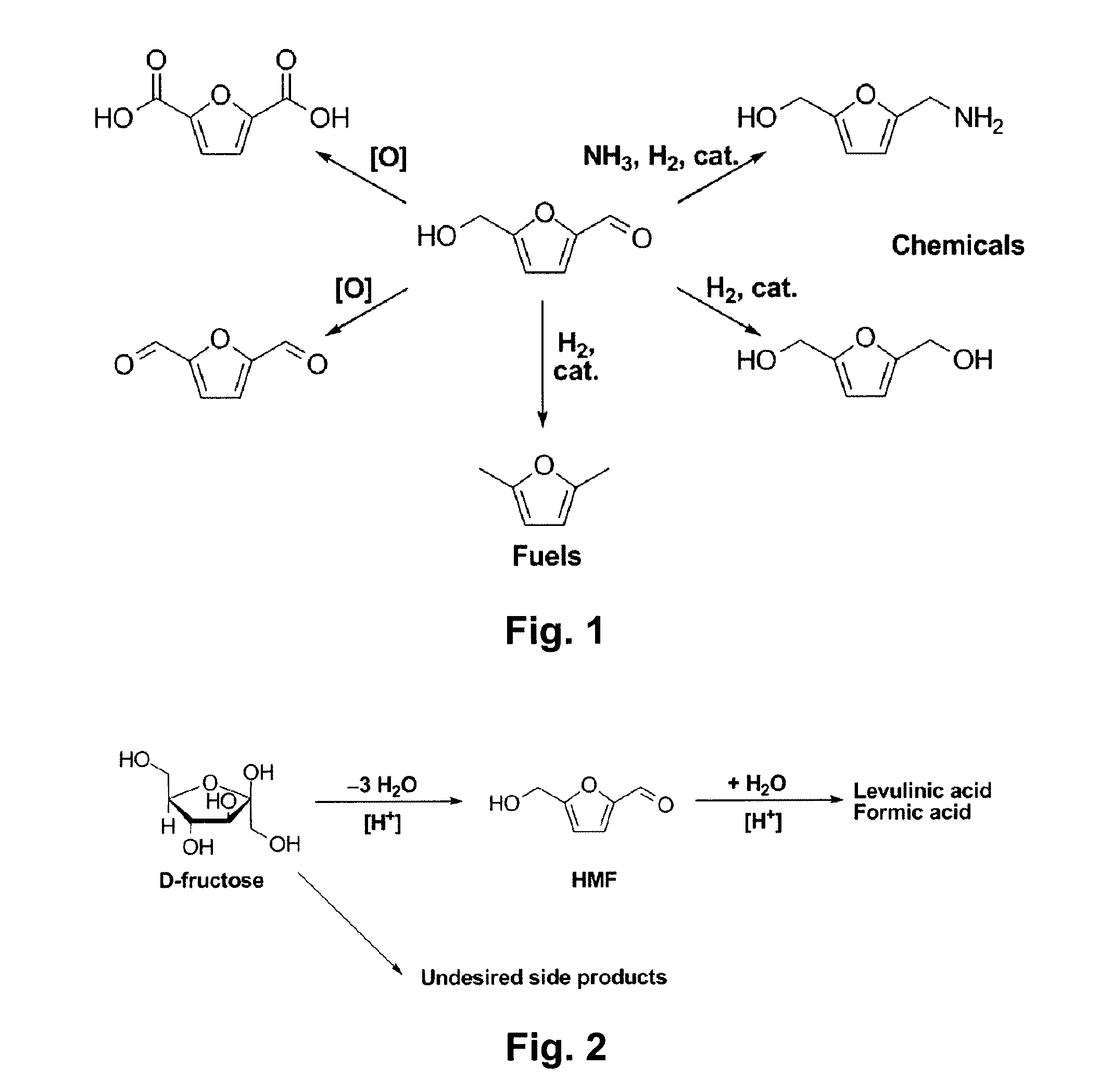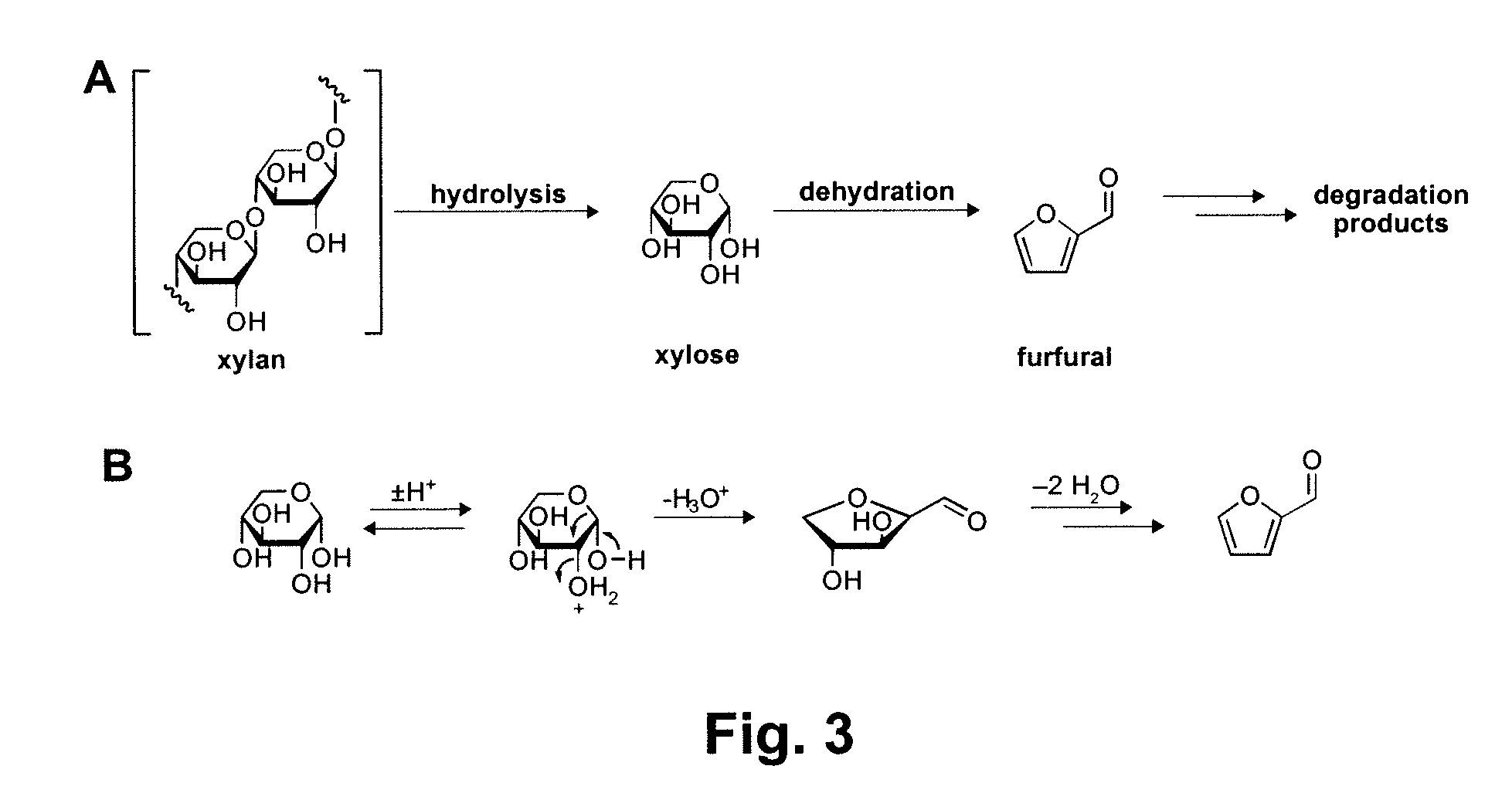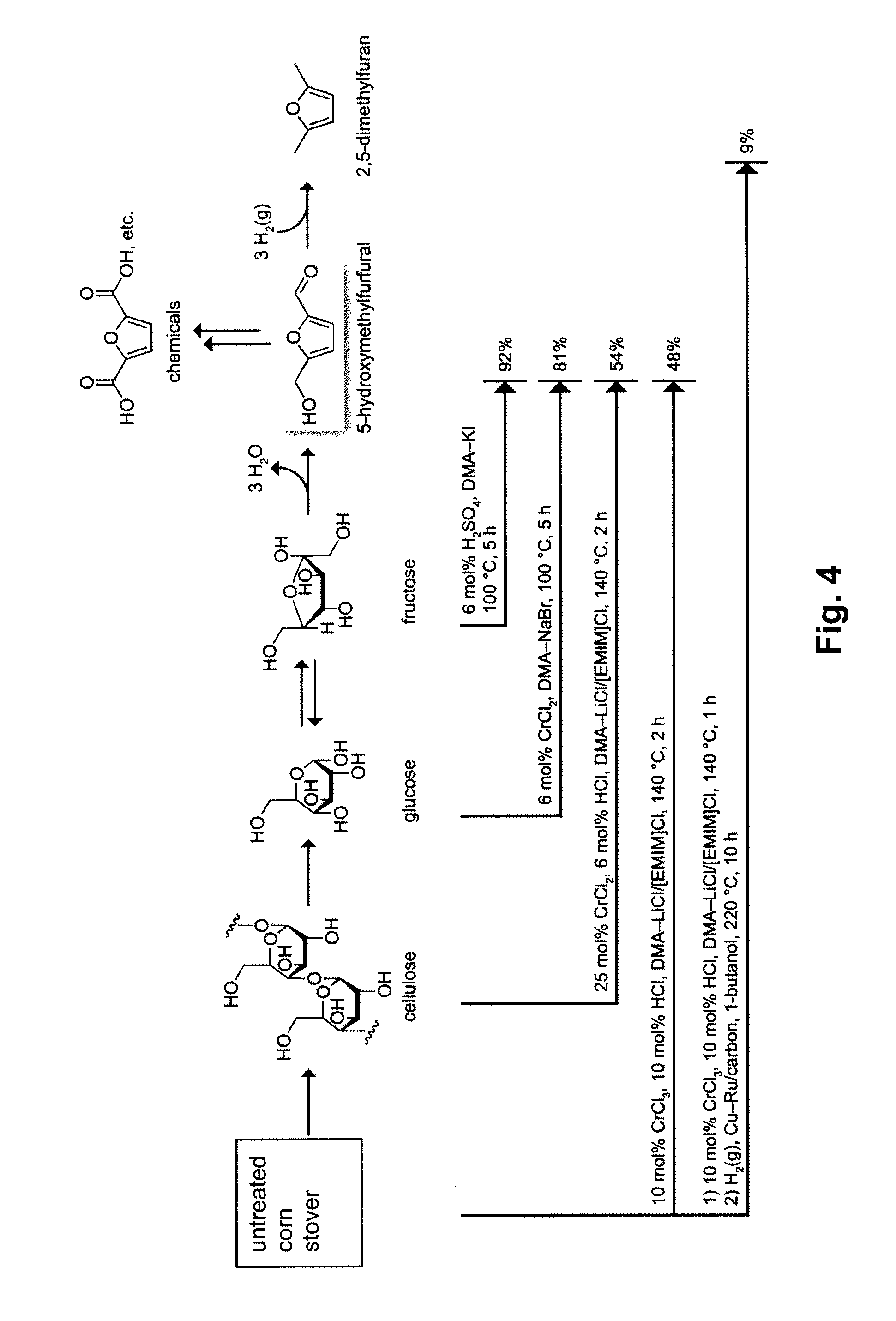Chemical transformation of lignocellulosic biomass into fuels and chemicals
a technology of lignocellulosic biomass and chemical transformation, which is applied in the direction of biofuels, sugar derivates, organic chemistry, etc., can solve the problems that acetonitrile and pyridine are not useful for the conversion of glucose to hm
- Summary
- Abstract
- Description
- Claims
- Application Information
AI Technical Summary
Benefits of technology
Problems solved by technology
Method used
Image
Examples
example 1
Production of HMF from Fructose
[0074]Fructose (10 wt %), catalyst, salt and any other additives (as indicated) were mixed in DMA in a glass vial. The vial was capped and the reaction mixture was stirred at the indicated temperature. At intervals aliquots of the reaction mixture were removed for HPLC analysis. The results are summarized in Table 1.
[0075]
TABLE 1Production of HMF from Fructoseamolarcatalystadditivestemp.timeyieldsolvent(mol %)(wt %)(° C.)(h)(%)DMA-LiCl (10%)——80558DMA-LiCl (10%)——100462DMA-LiCl (10%)——120265DMA-LiCl (10%)——1400.555DMA-LiCl (10%)H2SO4, 6—80466DMA-LiCl (10%)CuCl2, 6—80466DMA-LiCl (10%)RuCl3, 6—80458DMA-LiCl (10%)PdCl2, 6—80560DMA-LiCl (10%)CuCl, 6—80562DMA-LiCl (1%)H2SO4, 6—80157DMAH2SO4,6—80116DMA-LiCl (10%)H2SO4, 6—100563DMA-LiCl (10%)CuCl2, 6—100455DMA-LiCl (10%)RuCl3, 6—100565DMA-LiCl (10%)PdCl2, 6—100462DMA-LiCl (10%)CuCl, 6—100562DMA-LiCl (10%)CrCl2, 6—100566DMA-LiCl (10%)H2SO4, 6—120168DMA-LiCl (0.5%)H2SO4, 6—1200.281DMA-LiCl (10%)CuCl, 6—120371DM...
example 2
Production of HMF from Glucose
[0080]Glucose (10 wt %), catalyst, salt and any other additives (including ionic liquid) were mixed in DMA in a glass vial. The vial was capped and the reaction mixture was stirred at the indicated temperature. At intervals aliquots of the reaction mixture were removed for HPLC analysis. The results are summarized in Table 2.
[0081]
TABLE 2Production of HMF from Glucoseaadditivestemp.timemolar yieldsolventcatalyst (mol %)(wt %)(° C.)(h)(%)DMA-LiCl (10%)——1006DMA-LiCl (10%)—[EMIM]Cl, 201006DMACrCl2, 6—100460DMACrCl2, 6—120347DMACrCl2, 6[EMIM]Cl, 8120357DMACrCl2, 6[EMIM]Cl, 5100664DMACrCl2, 6[EMIM]Cl, 10100667DMACrCl2, 6[EMIM]Cl, 20100667DMA-LiCl (10%)CrCl2, 6—100560DMA-LiCl (10%)CrCl2, 6—120353DMA-LiCl (10%)CrCl2, 6—120255DMA-LiCl (10%)CrCl2, 6[EMIM]Cl, 5100658DMA-LiCl (10%)CrCl2, 6[EMIM]Cl, 10100661DMA-LiCl (10%)CrCl2, 6[EMIM]Cl, 20100662DMACrCl2, 6[EMIM]Cl, 5120567DMACrCl2, 6[EMIM]Cl, 10120362DMACrCl2, 6[EMIM]Cl, 20120363DMA-LiCl (10%)CrCl2, 6[EMIM]Cl, 5...
example 3
Production of HMF from Glucose in Various Solvents
[0084]Exemplary procedure: Glucose (10 wt %), LiCl (10 wt %), and CrCl2 (6 mol %) were mixed in the indicated solvent in a glass vial. The vial was capped and the reaction mixture was stirred at the indicated temperature. After 3.25 h the reaction mixture was analyzed by HPLC. Experiments were performed with the indicated solvent with LiCl (10 wt %) and catalyst for the listed time at the listed temperature. The average results for two trials are summarized in Table 3.
[0085]
TABLE 3Production of HMF from Glucose in Various Solventsmolarcatalystadditivestemp.timeyieldbsolvent(mol %)(wt %)(° C.)(h)(%)DMACrCl2, 6—1203.2545N,N-dimethylformamideCrCl2, 6—1203.2536N-methylpyrrolidoneCrCl2, 6—1203.2545sulfolaneCrCl2, 6—1203.2535dimethylsulfoxideCrCl2, 6—1203.2546acetonitrileCrCl2, 6—1203.250dioxaneCrCl2, 6—1203.25131-butanolCrCl2, 6—1203.254pyridineCrCl2, 6—1203.2501-ethyl-2-pyrrolidinoneCrCl2, 6—1203.2532N-methylcaprolactamCrCl2, 6—1203.2538...
PUM
| Property | Measurement | Unit |
|---|---|---|
| temperature | aaaaa | aaaaa |
| pressures | aaaaa | aaaaa |
| temperatures | aaaaa | aaaaa |
Abstract
Description
Claims
Application Information
 Login to View More
Login to View More - R&D
- Intellectual Property
- Life Sciences
- Materials
- Tech Scout
- Unparalleled Data Quality
- Higher Quality Content
- 60% Fewer Hallucinations
Browse by: Latest US Patents, China's latest patents, Technical Efficacy Thesaurus, Application Domain, Technology Topic, Popular Technical Reports.
© 2025 PatSnap. All rights reserved.Legal|Privacy policy|Modern Slavery Act Transparency Statement|Sitemap|About US| Contact US: help@patsnap.com



